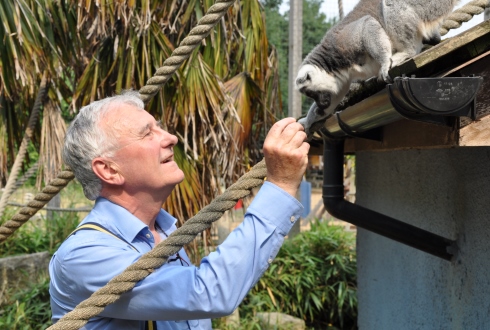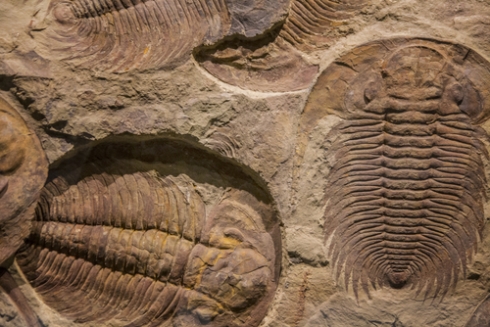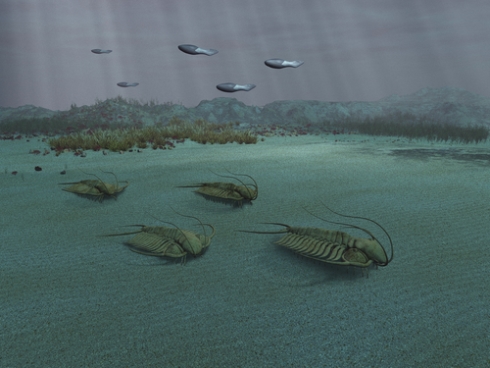The Trilobite Tales

Author, trilobite expert and naturalist Richard Fortey's work entwines stories about people, wildlife and the ancient Earth from which it all came. He tells Tom Ireland about how he became 'Mr Trilobite' and what fossils from hundreds of millions of years ago tell us about the ground we stand on now
The Biologist 64 (3) p26-29
Richard Fortey found his first trilobite aged just 14, after braving gorse bushes to break rocks on St David's Peninsula, the westernmost tip of Wales.
This first encounter with a trilobite – which turned out to be roughly 500 million years old – sparked a passion that would lead to 35 years studying them at the Natural History Museum and a career in natural history writing and documentary making.
Almost 60 years later, Fortey is still obsessed with these ancient, extinct arthropods and continues to study them in retirement from his office in the museum.
"I don't know what exactly it was about trilobites," recalls Fortey, who was a keen naturalist from a very young age, "but I think it was something to do with their sheer antiquity – the older something was, the stranger it was and therefore the more interesting."
Fossils don't get much older than trilobites, extinct marine arthropods that date back to a time before animals had backbones and even before there were any plants on land. They were already well diversified as soon as they appeared as part of the Cambrian "explosion", the relatively short period of evolutionary history where a huge radiation of multicellular life forms suddenly appear on the tree of life.
 Trilobite fossils, showing the distinctive segmented exoskeleton divided into three lobes
Trilobite fossils, showing the distinctive segmented exoskeleton divided into three lobes After taking geology at A level, Fortey took his passion for trilobite fossils to Cambridge University, where he studied palaeontology ("a good halfway house between geology and zoology," he says). Once there, good fortune meant his supervisor happened to be one of the world's foremost experts on trilobites, Harry B Whittington.
This wasn't the only bit of luck early in Fortey's career. As a field assistant on an undergraduate trip to Spitsbergen in Svalbard, Fortey and his colleague found "huge numbers" of trilobites where they had never been found before.
Furthermore, every single one of them was new to science.
His more senior colleague from the trip left Cambridge, which "meant all these lovely trilobites fell into my waiting hands". Fortey spent the next 10 years describing these weird and wonderful new organisms, and trying to deduce all the different life habits they may have had.
This element of his work put him in high demand with geologists, as he could suggest how the Earth looked hundreds of millions of years ago in any given place by studying the trilobites found there.
"It became clear that trilobites could inhabit three or four major habitat types. I could find shallow water ones where shallow seas had flooded former continents, deeper-water ones surrounding the edges of the continents, sometimes intercontinental ones. This coincided with a revolution in plate tectonics, when people started to realise that during the age of these trilobites [450 million years ago], the continents were totally different – it was even before the ancient supercontinent Pangaea came together.
"So for 20 years I was involved in trying to reconstruct what the world was like, using trilobites to define the position of the continents."
I ask Fortey whether he thinks trilobites are beautiful – knowing the answer – and suggest that some people might find the idea of these creatures scuttling about in large numbers horrifying. He takes down an old monograph from his packed bookshelves and shows me what a diverse, bizarre, unique and, yes, beautiful set of creatures the trilobites were.
We look at minute ones, massive ones, pretty ones, freaky ones, spiny ones, horned ones, ones with bizarre appendages. One has some kind of spatula at the front, some have ornate pitted shells over them and there is a whole genus with tridents sticking out of their heads.
"I often finish my lectures by challenging the audience to think of what its function could be," says Fortey, as we stare at a 400-million-year-old creature with what looks to me like a whisk on its head. "You can keep your dinosaurs," he says, having proved his point. "These are pretty cool animals don't you think?"

• Trilobites lived on Earth for almost 300 million years, first appearing in the fossil record around 530 million years ago in the Cambrian.
• The name 'trilobite' derives from the fact their bodies are divided into three lobes along their length.
• A calcite exoskeleton protected the upper surface of these marine arthropods from predators, but articulated so that many species were able to roll tightly into a ball.
• They were among the first animals to develop complex eyes, and diversified into many forms – around 20,000 species have been discovered and described so far, including large benthic predators, small filter feeders and large-eyed pelagic animals.
• After a long period of decline, the last species were wiped out close to the Permian mass extinction event around 250 million years ago.
The dazzlingly diversity found among trilobites led Fortey and his colleagues to question the idea of the Cambrian Explosion.
"Derek Briggs and I were the first people to take a kind of cladistic and cold-eyed look at the way these weird Cambrian animals interrelated. The idea they included many new phyla was not supported, and instead we found that a lot of them could be fitted into the stem part of the major tree of life. The more people worked on the Cambrian, the more the phyla routed back to somewhere in the stem of the tree, and the question was whether it was reasonable to expect all these different designs to have appeared in that explosive timescale."
Although the debate is ongoing, Fortey thinks there was an extended period – in the late Precambrian – when designs were initiated but not preserved as fossils. "That was probably the most reasonable explanation: the important design work was done in animals of quite small or very small size, before the Cambrian, that did not get preserved."
For a long time, trilobites were thought to be the 'original' primitive arthropod, but the reality is their tough and large calcite exoskeleton made them much more likely to be preserved. Other, soft bodied arthropods from the Cambrian have since been discovered at exceptional preservation sites, such as the Burgess Shale, Canada. The exoskeleton is also what enabled trilobites to move into so many niches and made them so successful: there are more than 20,000 described species in 5,000 genera and they lived for nearly 300 million years.
"The exoskeleton was versatile and it meant they were quite well protected – they learnt to roll up into tight balls for protection, even the spiky ones. I think they diversified into everything that the crustaceans do now. The big ones, some as large as a lobster, have lots of features that suggest they were predators."
So what killed them?
"They declined in diversity for quite a long time, but so did lots of other things," says Fortey, like a man explaining why his team lost. "The extinction event at the end of the Permian took out 90% of animal life and trilobites were not one of the arthropods that came through the filter. I don't think it helped that they never left the marine environment – the ocean-living organisms were much more greatly affected."
As a former employee of the museum, Fortey was not allowed a personal fossil collection – it is seen as a potential conflict of interest – but he indulges his inner "boy naturalist" at home with his own mycology laboratory, and for his latest book he bought a four-acre patch of woodland near his home and forensically examined its natural and human history.
"By the time most people retire, that was when I started doing TV. My first series gave me a bit of money in the bank, which is unusual for an academic, and that's when we bought our piece of woodland.
"At that stage, it was just to have a piece of woodland near my house to go and sit in. However, any naturalist starts getting curious after a while and I thought it would be fascinating to see how many different organisms we had in the wood.
"I got help from friends at the museum so we could gradually build up a picture. Then I hit on the idea that it could be a literary project. I started delving into the human history of the wood because you can't understand why it's like it is without showing how we were entwined with it. I began to realise how complicated and changing the countryside is."
For an author of science books, Fortey's prose is unusually rich with human stories and literary references – the opening chapter of his book Trilobite! begins with him in an earthy old boozer in Boscastle, North Cornwall, from where he takes the reader on a ramble up on to the cliffs above, describing the immense forces and unfathomable geological time that folded and crushed rock into the shapes before him. He eventually reaches Beeny Cliff, the setting for a scene in the Thomas Hardy novel A Pair of Blue Eyes which involves a dark encounter with a trilobite.
"I think the way to approach science writing is to mediate it through stories and narratives. The problem with many science writers, at least scientists who become writers, is that they are too interested in the theory.
For example, I could describe the palaeogeography work I do in a very dry way, about how plate tectonics work, or I could go to an outcrop, see what fossils I find and tell the story of what happened there and why. I don't dodge the science, but I make it a journey that people will enjoy going on with me."
As the conversation turns to recent threats to science and science communication, and the obfuscation between evidence, rhetoric and 'alternative facts', Fortey suddenly becomes more animated.
"Bollocks!" he cries. "It really, really irritates me. I hate people who think opinion is the same as knowledge. I really do."
He hopes his popular science work bridges the gap between those who "emote vaguely" about the joys of the countryside and the hardcore, "heads down" work of the research scientists describing species in a museum.
"I do think that getting down to the nitty-gritty – animals, plants, roots, fungi and how they live and interact – can genuinely increase people's love of nature, and knowledge and feel for the countryside. I want people to go out armed with some geological knowledge and look at the land in a different way, with a deeper understanding."
This month Richard was awarded the Silver Medal of the Zoological Society of London. His book Wood for the Trees: A Long View of Nature from a Small Wood is out now
Richard Fortey Hon FRSB FRS is a palaeontologist specialising in trilobites. A former president of the Geological Society of London and vice-president of the British Mycological Society, he has written popular science books on subjects including geology, palaeontology, evolution and natural history. He has also presented several television series, most recently Islands of Evolution for BBC Four. He was made an Honorary Fellow of the RSB in 2016.


